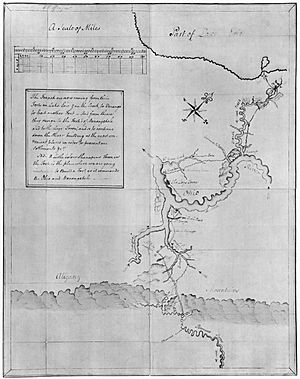Venango Path facts for kids
The Venango Path was an old trail used by Native Americans. It connected two important water routes in Pennsylvania, USA. One end was at the Forks of the Ohio, which is now the city of Pittsburgh. The other end was at Presque Isle, a bay on Lake Erie. The trail was like a shortcut, allowing people to carry their canoes and goods between these waterways. This is called a portage. The path was named after a Lenape village called Venango. This village was located where French Creek meets the Allegheny River. Today, that spot is the city of Franklin, Pennsylvania.
Contents
George Washington's Journey
A Young Leader's Mission
In December 1753, a 21-year-old George Washington traveled the Venango Path. He was a major in the Virginia militia. With him was an explorer named Christopher Gist. Their mission was to deliver a message to the French. The French had built Fort Le Boeuf near the Lenape village of Venango.
The message told the French to leave the area. The British claimed control of this land. Both sides had been arguing over it for a long time.
Facing Winter Weather
The weather was very bad. Washington and his men left the trail at the Forks of the Ohio. They found shelter in a Native American village called Logstown. This village was near what is now Ambridge, Pennsylvania.
After a few days, they continued their journey northeast. They passed through what is now Cranberry. They reached a place called Murdering Town. This town was along the Connoquenessing Creek.

A Dangerous Return Trip
On their way back from Fort Le Boeuf, Washington and Gist left the Venango Path. They were at Murdering Town, near today's Evans City and Harmony, Pennsylvania. Gist called this area the "southeast fork of Beaver creek" (which is now the Connoquenessing Creek).
A Native American from the village offered to guide them. He said he knew a different trail to the Forks of the Ohio. After walking several miles, the guide turned on them. He fired his gun at Washington and Gist. Luckily, they were not hurt. Gist wanted to punish the guide, but Washington ordered him released.
After this scary event, the two men traveled "across country." They used a compass to find their way through the forest. They reached the start of Piney Creek. From there, they traveled downstream to the Allegheny River. They spent the night on a small island. This island was later called Washington's Landing.
They then moved a short distance downriver. They were just above the Native American village of Shannopin's Town. From there, they continued their long journey back to Williamsburg, Virginia. This was the capital of the colony. They arrived on January 16, 1754.
The French and Indian War
A Military Road
The Venango Path became very important during the early years of the French and Indian War. The French controlled western Pennsylvania at this time. They improved the trail and used it as a military road.
This road connected a series of French forts. These forts stretched from Lake Erie to Pittsburgh. They were built to protect the area from the British colonists. The forts included:
- Fort Presque Isle on Lake Erie
- Fort Le Boeuf (today's Waterford)
- Fort Machault at Venango (today's Franklin)
- Fort Duquesne at today's Pittsburgh
British Control
In 1758, the British drove the French out of Western Pennsylvania. The French burned and left all four forts. But the British rebuilt them in 1759. They renamed Fort Machault as Fort Venango. They also renamed Fort Duquesne as Fort Pitt. The British continued to use the Venango Path as a military road.
End of the Trail's Use
Four years later, in 1763, Pontiac's War began. Native American warriors from several tribes attacked. They burned Forts Presque Isle, Le Boeuf, and Venango. They hoped to push the colonists out of the region.
After the Battle of Bushy Run, a British army defeated the combined warrior groups. The Native Americans moved into Ohio and further west. They stopped using the Venango Path. After the fighting ended in western Pennsylvania, the British also stopped using the trail for major military purposes.

